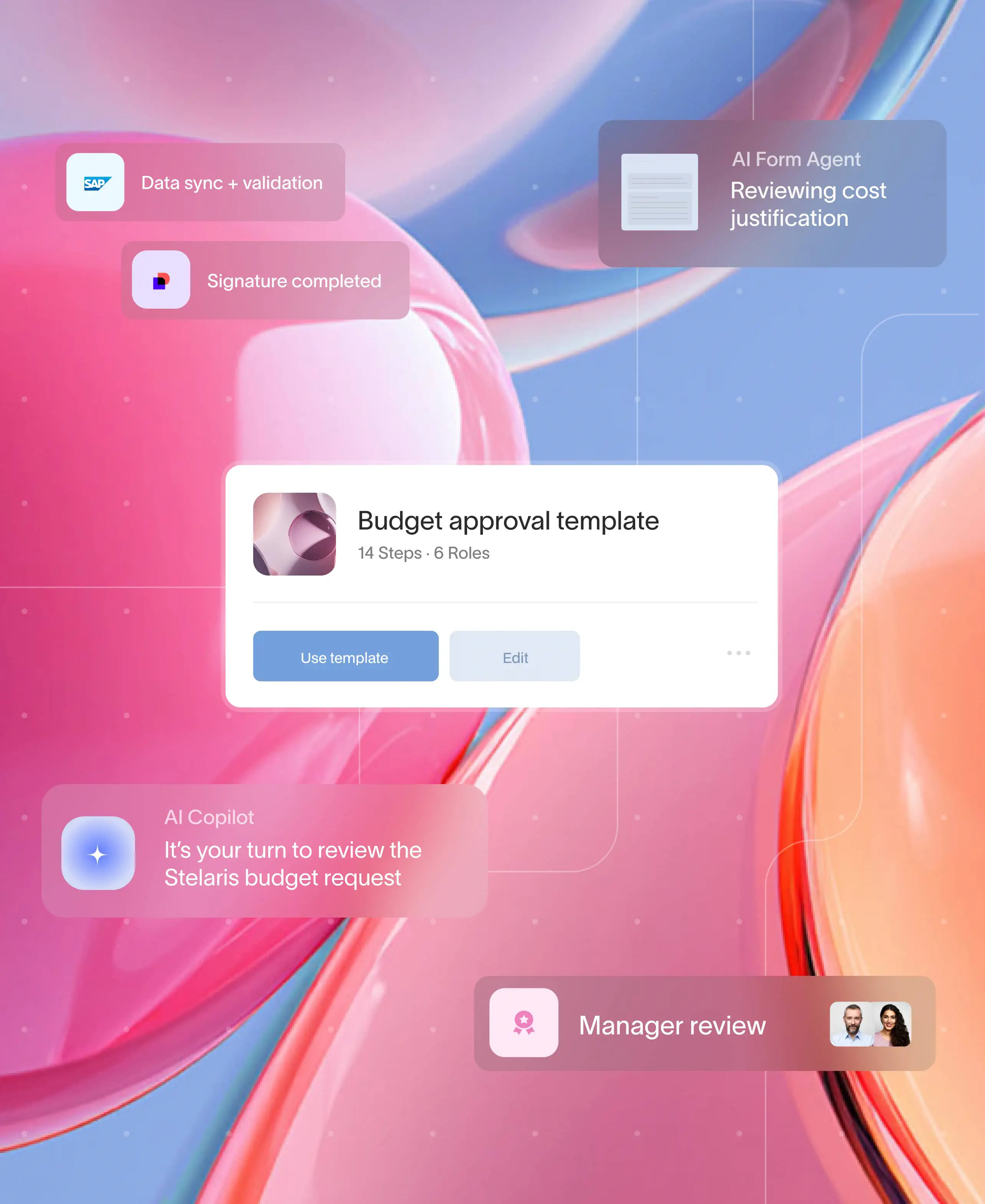
At a glance
Contracts are the backbone of every business relationship. They define responsibilities, set expectations, and protect organizations from risk. Yet despite their importance, the way contracts are managed often creates friction instead of clarity. Teams lose time chasing signatures across email threads, multiple stakeholders weigh in without a clear process, and deadlines slip by unnoticed. According to EY research, contract managers spend more than 30% of their time on administrative tasks like tracking approvals and searching for documents — a massive drain on productivity.
A contract management workflow addresses this by bringing structure, accountability, and visibility to every stage of the contract lifecycle. Unlike ad hoc methods, a workflow ensures contracts move from drafting to renewal without unnecessary delays. But not all platforms are created equal. Many orchestration tools were built for internal processes only, or operate as “headless” systems that lack a client-facing experience. Real-world contract management demands more — coordination between internal teams and external stakeholders in a seamless, auditable process.
What is a contract workflow process
A contract workflow process is the structured sequence of steps that moves a contract from creation to renewal. Unlike the broader contract lifecycle, which refers to the entire lifespan of an agreement, the workflow process focuses on the specific actions and approvals needed to keep contracts moving.
For example, while the lifecycle covers everything from drafting to renewal, the workflow defines who drafts, who approves, and how signatures are captured. By mapping this out, organizations create repeatable processes that prevent delays and errors.
For a full overview of how workflows fit into the bigger picture, see our complete guide to contract management workflow.
Common stages in the contract workflow process
Every workflow process includes a familiar set of stages.
Drafting begins with templates or custom authoring. Without structure, this step is vulnerable to inconsistent language and missed clauses.
Review and negotiation comes next. Internal teams refine terms while external parties provide redlines. This is often the most time-consuming stage, and without centralized collaboration, version confusion is inevitable.
Approvals follow, with compliance checks from legal, finance, or executives. Approvals routed manually through email frequently cause bottlenecks.
Execution finalizes the contract with signatures. Even today, many businesses face delays because external parties do not have a simple way to sign digitally.
Monitoring and renewal completes the loop. Contracts must be stored securely, tracked for milestones, and renewed or terminated on schedule.
For a closer look at how negotiation fits into this process, read our article on the contract negotiation workflow.
Why traditional contract workflow processes fail
Despite their importance, many businesses still run contract workflows manually. The pain points are familiar:
Emails create delays. Approval requests get buried in inboxes and it’s unclear who owes the next action.
Version chaos wastes time. Multiple drafts circulate, increasing the risk of errors and making reconciliation painful.
External bottlenecks slow deals. Clients, vendors, and partners often lack an easy way to participate, leading to long pauses.
Compliance gaps emerge. Without centralized tracking, approvals and renewals slip by unnoticed, creating risk.
These problems show why a workflow process is more than just an internal checklist. To be effective, it must orchestrate both internal and external participants in one streamlined flow.
What to look for in a modern contract workflow solution
When evaluating workflow tools, it is not enough to choose any orchestration platform. Many are built for internal-only processes or operate as headless systems that require IT resources to surface to users. The right solution should be designed for client-facing workflows.
Look for platforms that offer:
Client-facing participation so external parties can review, approve, and sign without friction.
A user-friendly interface to replace scattered email and PDF exchanges.
Secure collaboration tools including file sharing, comments, and annotations.
Audit-ready tracking that logs every action for compliance.
Intelligent nudges and reminders so contracts never stall at a single step.
Moxo’s workflow orchestration platform was built for these multi-party use cases. By combining automation, human approvals, and AI-driven nudges in one experience, it helps businesses orchestrate contracts without the chaos of emailsand manual follow-ups.
Real-world example of a contract workflow process
Imagine a marketing agency signing a new client. The contract begins with a draft prepared by sales. Legal reviews and redlines the terms. Finance approves the pricing. Finally, the client signs.
Without a defined workflow, this process would take weeks of emails and repeated follow-ups. With an orchestrated workflow, every step is assigned, tracked, and completed in sequence. Internal teams and external stakeholders both know when it’s their turn, and the contract closes faster with fewer errors.
This example mirrors broader processes like the contracts process, where multiple steps and stakeholders make orchestration critical.
Best practices for building a contract workflow process
Successful organizations don’t just map a workflow once — they refine it continuously.
Use templates so every contract starts from a consistent baseline.
Define roles clearly so approvals move in sequence without bouncing around.
Automate reminders so no one forgets their task.
Track performance with reporting to identify bottlenecks.
For businesses managing higher volumes, these practices combine with orchestration to deliver efficiency at scale.
Frequently asked questions
What is a contract workflow process
A contract workflow process is the structured series of steps that moves a contract from creation to renewal, ensuring nothing gets lost or delayed.
How does a contract workflow differ from the contract lifecycle
The lifecycle covers the entire lifespan of an agreement. The workflow process defines the specific actions and approvals that move the contract forward.
What are the risks of not using a contract workflow process
Risks include missed deadlines, non-compliance, lost documents, and slower deal cycles.
Can contract workflow processes be automated
Yes. The most effective platforms combine automation with human approvals and external stakeholder collaboration to ensure contracts move without bottlenecks.
Get contracts signed without the back and forth
Too often, contracts stall because teams rely on emails, attachments, and reminders that get lost in the shuffle. With the right orchestration platform, every step from drafting to approval to signature happens in one clear flow. Moxo makes it simple to keep contracts moving so you close faster and with less effort. Book a 15 minute demo and discover how Moxo can help you orchestrate contract workflows that run smoothly from start to finish.





